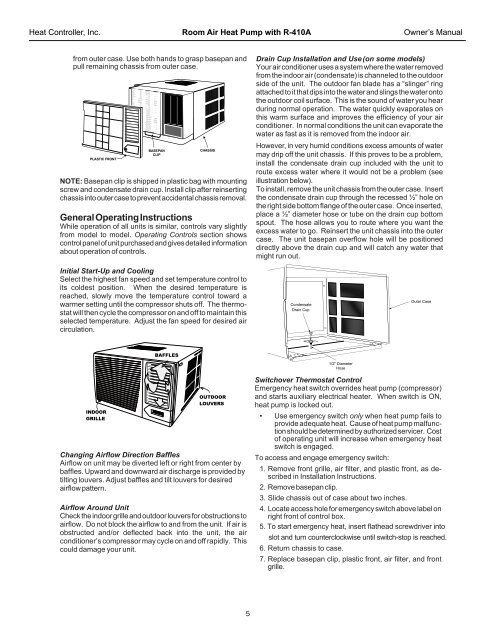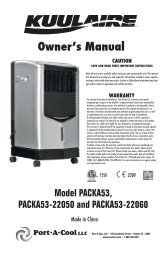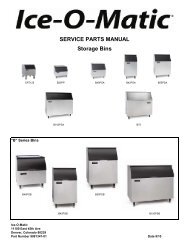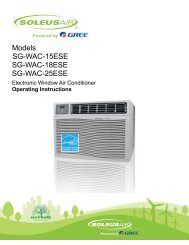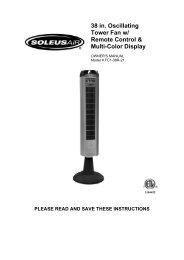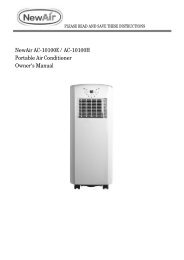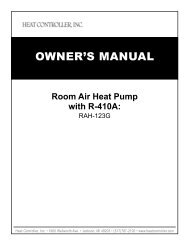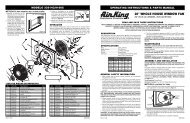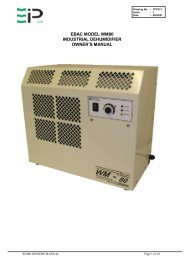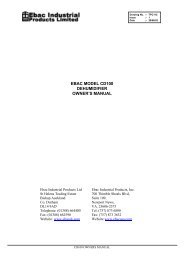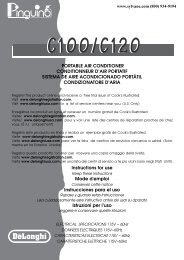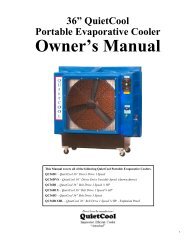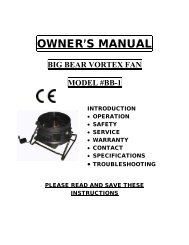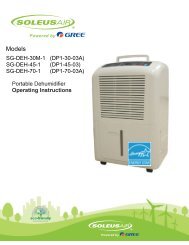OWNER'S MANUAL - Comfort-Aire
OWNER'S MANUAL - Comfort-Aire
OWNER'S MANUAL - Comfort-Aire
You also want an ePaper? Increase the reach of your titles
YUMPU automatically turns print PDFs into web optimized ePapers that Google loves.
Heat Controller, Inc. Room Air Heat Pump with R-410A Owner’s Manualfrom outer case. Use both hands to grasp basepan andpull remaining chassis from outer case.PLASTIC FRONTBASEPANCLIPCHASSISNOTE: Basepan clip is shipped in plastic bag with mountingscrew and condensate drain cup. Install clip after reinsertingchassis into outer case to prevent accidental chassis removal.General Operating InstructionsWhile operation of all units is similar, controls vary slightlyfrom model to model. Operating Controls section showscontrol panel of unit purchased and gives detailed informationabout operation of controls.Drain Cup Installation and Use (on some models)Your air conditioner uses a system where the water removedfrom the indoor air (condensate) is channeled to the outdoorside of the unit. The outdoor fan blade has a “slinger” ringattached to it that dips into the water and slings the water ontothe outdoor coil surface. This is the sound of water you hearduring normal operation. The water quickly evaporates onthis warm surface and improves the efficiency of your airconditioner. In normal conditions the unit can evaporate thewater as fast as it is removed from the indoor air.However, in very humid conditions excess amounts of watermay drip off the unit chassis. If this proves to be a problem,install the condensate drain cup included with the unit toroute excess water where it would not be a problem (seeillustration below).To install, remove the unit chassis from the outer case. Insertthe condensate drain cup through the recessed ½” hole onthe right side bottom flange of the outer case. Once inserted,place a ½” diameter hose or tube on the drain cup bottomspout. The hose allows you to route where you want theexcess water to go. Reinsert the unit chassis into the outercase. The unit basepan overflow hole will be positioneddirectly above the drain cup and will catch any water thatmight run out.Initial Start-Up and CoolingSelect the highest fan speed and set temperature control toits coldest position. When the desired temperature isreached, slowly move the temperature control toward awarmer setting until the compressor shuts off. The thermostatwill then cycle the compressor on and off to maintain thisselected temperature. Adjust the fan speed for desired aircirculation.CondensateDrain CupOuter CaseBAFFLES1/2" DiameterHoseINDOORGRILLEOUTDOORLOUVERSChanging Airflow Direction BafflesAirflow on unit may be diverted left or right from center bybaffles. Upward and downward air discharge is provided bytilting louvers. Adjust baffles and tilt louvers for desiredairflow pattern.Airflow Around UnitCheck the indoor grille and outdoor louvers for obstructions toairflow. Do not block the airflow to and from the unit. If air isobstructed and/or deflected back into the unit, the airconditioner’s compressor may cycle on and off rapidly. Thiscould damage your unit.Switchover Thermostat ControlEmergency heat switch overrides heat pump (compressor)and starts auxiliary electrical heater. When switch is ON,heat pump is locked out.• Use emergency switch only when heat pump fails toprovide adequate heat. Cause of heat pump malfunctionshould be determined by authorized servicer. Costof operating unit will increase when emergency heatswitch is engaged.To access and engage emergency switch:1. Remove front grille, air filter, and plastic front, as describedin Installation Instructions.2. Remove basepan clip.3. Slide chassis out of case about two inches.4. Locate access hole for emergency switch above label onright front of control box.5. To start emergency heat, insert flathead screwdriver intoslot and turn counterclockwise until switch-stop is reached.6. Return chassis to case.7. Replace basepan clip, plastic front, air filter, and frontgrille.55


